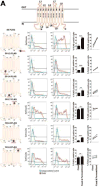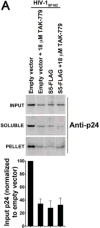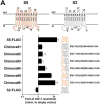Localization to detergent-resistant membranes and HIV-1 core entry inhibition correlate with HIV-1 restriction by SERINC5
- PMID: 29268082
- PMCID: PMC5801005
- DOI: 10.1016/j.virol.2017.12.005
Localization to detergent-resistant membranes and HIV-1 core entry inhibition correlate with HIV-1 restriction by SERINC5
Abstract
SERINC5(S5) is a multi-span transmembrane protein that potently blocks the infectivity of HIV-1 produced by human T-cells. The ability of S5 to restrict infectivity correlates with its presence in the virion, but the exact mechanism by which S5 restricts HIV-1 is unknown. Here we tested whether the core from HIV-1 virions containing S5 is delivered to the cytoplasm. Using the "fate of the capsid" assay, we demonstrated that the viral core of S5-restricted HIV-1 does not reach the cytoplasm of target cells, suggesting a block in the delivery of the core to the cytoplasm. In agreement with evidence suggesting that the viral determinants for S5 restriction map to the envelope of HIV-1, we observed that S5 induces conformational changes to the HIV-1 envelope. Further, we demonstrated that S5 localizes to detergent-resistant membranes (DRMs), as has been shown previously for the HIV-1 envelope in producer cells. In order to identify the determinants of S5 restriction, we explored the ability of all human SERINC proteins to restrict HIV-1. In contrast to human S5, we observed that human SERINC2(S2) did not restrict HIV-1, and was inefficiently incorporated into HIV-1 virions when compared to S5. Experiments using S5-S2 chimeric proteins revealed two functional domains for restriction: one necessary for S5 incorporation into virions, which does not seem to be necessary for restriction, and a second one necessary to change the HIV-1 envelope conformation, localize to DRMs, and block infection.
Keywords: Core; DRMs; Envelope; HIV-1; Restriction; SERINC2; SERINC5.
Copyright © 2017 Elsevier Inc. All rights reserved.
Figures




























Similar articles
-
SERINC5 Can Enhance Proinflammatory Cytokine Production by Primary Human Myeloid Cells in Response to Challenge with HIV-1 Particles.J Virol. 2021 Apr 12;95(9):e02372-20. doi: 10.1128/JVI.02372-20. Print 2021 Apr 12. J Virol. 2021. PMID: 33597208 Free PMC article.
-
HIV envelope tail truncation confers resistance to SERINC5 restriction.Proc Natl Acad Sci U S A. 2021 May 25;118(21):e2101450118. doi: 10.1073/pnas.2101450118. Proc Natl Acad Sci U S A. 2021. PMID: 34001619 Free PMC article.
-
The host-cell restriction factor SERINC5 restricts HIV-1 infectivity without altering the lipid composition and organization of viral particles.J Biol Chem. 2017 Aug 18;292(33):13702-13713. doi: 10.1074/jbc.M117.797332. Epub 2017 Jun 28. J Biol Chem. 2017. PMID: 28659343 Free PMC article.
-
SERINC as a Restriction Factor to Inhibit Viral Infectivity and the Interaction with HIV.J Immunol Res. 2017;2017:1548905. doi: 10.1155/2017/1548905. Epub 2017 Nov 22. J Immunol Res. 2017. PMID: 29359168 Free PMC article. Review.
-
SERINC5 as a New Restriction Factor for Human Immunodeficiency Virus and Murine Leukemia Virus.Annu Rev Virol. 2018 Sep 29;5(1):323-340. doi: 10.1146/annurev-virology-092917-043308. Annu Rev Virol. 2018. PMID: 30265629 Review.
Cited by
-
SARS-CoV-2 ORF7a potently inhibits the antiviral effect of the host factor SERINC5.Nat Commun. 2022 May 26;13(1):2935. doi: 10.1038/s41467-022-30609-9. Nat Commun. 2022. PMID: 35618710 Free PMC article.
-
Flow Cytometry Analysis of HIV-1 Env Conformations at the Surface of Infected Cells and Virions: Role of Nef, CD4, and SERINC5.J Virol. 2020 Feb 28;94(6):e01783-19. doi: 10.1128/JVI.01783-19. Print 2020 Feb 28. J Virol. 2020. PMID: 31852789 Free PMC article.
-
Natural HIV-1 Nef Polymorphisms Impair SERINC5 Downregulation Activity.Cell Rep. 2019 Nov 5;29(6):1449-1457.e5. doi: 10.1016/j.celrep.2019.10.007. Cell Rep. 2019. PMID: 31693887 Free PMC article.
-
SERINC5 Inhibits the Secretion of Complete and Genome-Free Hepatitis B Virions Through Interfering With the Glycosylation of the HBV Envelope.Front Microbiol. 2020 Apr 30;11:697. doi: 10.3389/fmicb.2020.00697. eCollection 2020. Front Microbiol. 2020. PMID: 32431673 Free PMC article.
-
SERINC5 counters retroviruses and non-retroviruses.Front Cell Infect Microbiol. 2025 Jan 20;14:1516806. doi: 10.3389/fcimb.2024.1516806. eCollection 2024. Front Cell Infect Microbiol. 2025. PMID: 39902183 Free PMC article. Review.
References
Publication types
MeSH terms
Substances
Grants and funding
LinkOut - more resources
Full Text Sources
Other Literature Sources
Medical
Molecular Biology Databases

